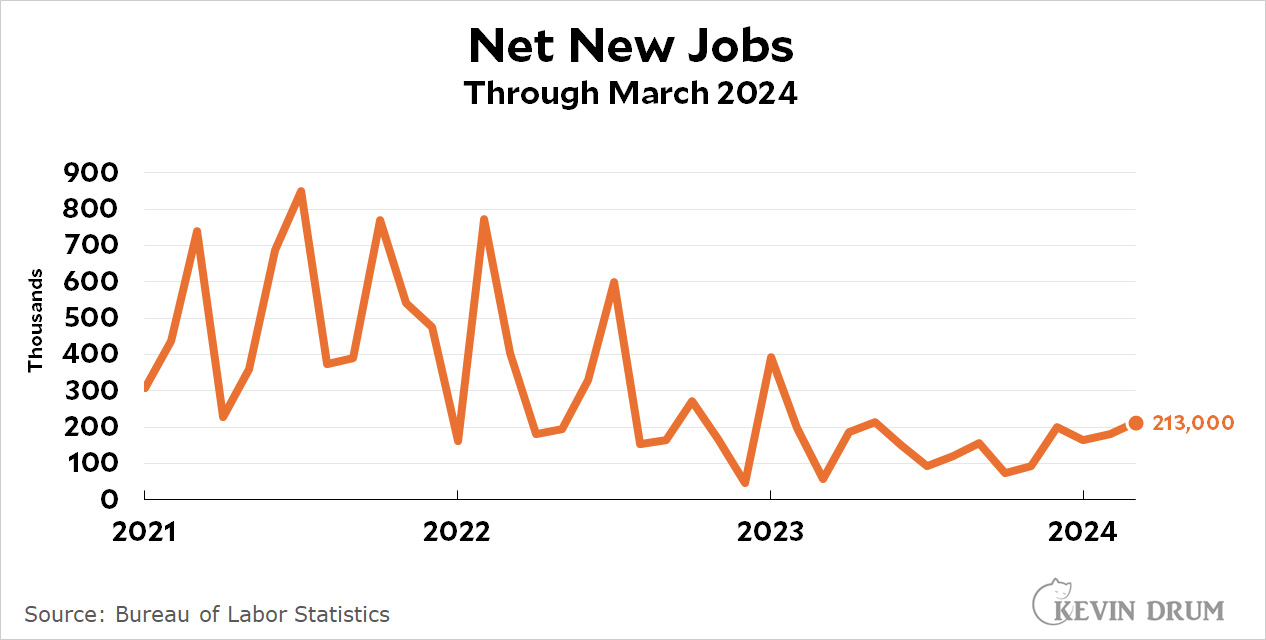The American economy gained 303,000 jobs last month. We need 90,000 new jobs just to keep up with population growth, which means that net job growth clocked in at 213,000 jobs. The headline unemployment rate ticked back down to 3.8%.
 I normally use a bar chart for the monthly jobs numbers, but I switched to a line chart this month to highlight how flat they've been for the past year. All the way through the end of 2022 the employment figures dropped steadily, but then they suddenly plateaued. This is evidence in favor of a soft landing for the economy.
I normally use a bar chart for the monthly jobs numbers, but I switched to a line chart this month to highlight how flat they've been for the past year. All the way through the end of 2022 the employment figures dropped steadily, but then they suddenly plateaued. This is evidence in favor of a soft landing for the economy.
There was an odd racial cast to the unemployment numbers in March. The unemployment rate for white workers didn't change at all, but it spiked up 0.8 percentage points for Black workers. At the same time it was down 0.5 points for Hispanic workers and 0.9 points for Asian workers. Those are extremely large changes for a single month.
On an annualized basis, average weekly earnings were up a whopping 8.0% from February. Even accounting for last month's inflation spike, that comes to 2-3% in real terms. Not bad.

Instead of sticking with the same 90K figure, consider using the monthly change in working-age (15-64) persons.
(Third try, trying to see what goes into the abyss of lost comments.)
About the variation by ethnicity: One-month aggregate data is noisy, data for minority subgroups will be even noisier. I wouldn’t read too much into it.
When the country is at or near full employment, employment numbers CAN'T go up much. Somewhere around flat is the best you can get.
Depends on how, and who, defines full employment. If it's the gov't, it's the lowest unemployment rate achievable without inflation. Others might see it as the rate of underemployment matching the unemployment rate.
My take is structural. People quit jobs; people die; people retire; even in the best economy, businesses fail and people are laid off. All these things mean that at any given moment there will be vacant jobs and there will be people looking for work. At very low unemployment rates, there will be skills mismatches; there will be jobs in such demand that there just aren't enough qualified people to fill them, and other jobs for which there are more qualified people than positions. It seems that those factors mean that an unemployment rate of about 3% is as low as it can go.
Post-WW low is ~2.5%.
It wasnt long ago that that 4 or 5% was the common wisdom.
Even the difference in 3.5% and 2.5% (both about 3%) is what.....1.6 million people with a job? Plus lots of raises and job improvements for everyone else.
The "non-accelerating inflation rate of unemployment" which is a concept economists use a lot, is estimated at 4 to 5 %. Structural full employment is a different concept. The economy being what it is, both rates change over time.
But... my neighbor's cousin got laid off from his job last week, so the economy is still terrible.
"A recession is when my neighbor loses his job. A depression is when I lose my job."
How long will these numbers continue until Kevin Drum has to back off his quite-certain prediction that a recession is just around the corner? Or will he simply wait until the business cycle comes around, as it inevitably will?